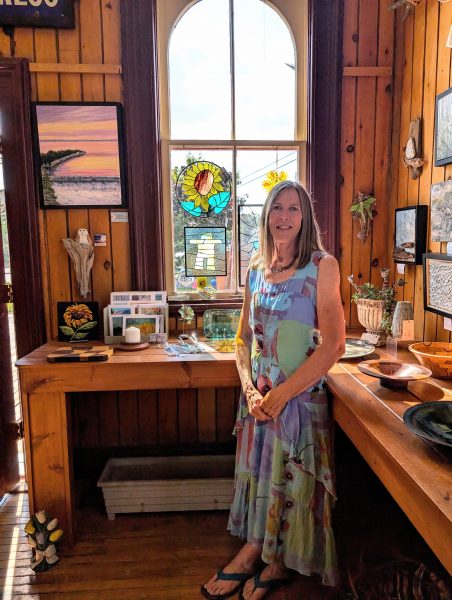The Business Advocate

The road to making a sustainable living as an artist is one filled with twists, turns, and plenty of creativity — not just in the art itself but in how artists diversify their income and adapt to the ever-changing economy and market conditions. For the artists in and around Kawartha Lakes, making a full-time living through art is both a challenge and a passion, requiring resourcefulness, adaptability, and a willingness to embrace new opportunities.
Bonnie Thomson, a stained-glass artist in Seagrave who runs Bonnie Thomson Glass and co-owns Meta4 Gallery in Port Perry, has spent decades turning her passion into a sustainable business. For 26 years, Thomson has diversified her income through teaching, restoration work, and commissions. Her business evolved to meet both her financial needs and her family’s schedule, running classes at night once the kids were in bed and during the day when they were finally in school. “If I needed more money, I would just run another class,” she recalls about managing finances in the early days.
For Thomson, teaching not only supports her financially but also keeps her inspired. “My students bring up things that seem old to me but can become fresh again with new perspectives.” Thomson has further diversified her income by selling art supplies as a natural extension of her classes. “I have an addiction to glass, I think” she jokes, referring to the cases in her studio filled to the brim with glass and supplies.
When Thomson sees an opportunity in the market, she doesn’t hesitate to jump at the chance to fill the void, as she did with the conception of the Scugog Studio Tour, a spring counterpart of the Victoria County Studio Tour, and the Renaissance Festival in Port Perry. In 2005, she co-founded Meta4 Gallery and eventually discovered that offering a variety of art classes there helped fill the financial void during slow retail seasons, noting that people are more likely to spend money on learning new skills than buying additional goods after the holidays.
Thomson’s philosophy of saying “yes” has served her well, helping her to expand into restoration work, which eventually led her to restore the windows at the Lucy Maud Montgomery Church in Leaskdale. She admits that running a business while maintaining her creative practice has been a balancing act and sees immense value in having good business partners and a strong support system. “You can’t always do it by yourself, because it cuts into your creativity,” she says, urging artists to consider bartering or trading for services they might not be able to afford, such as social media or marketing support.

For Bev and Paul Williams of Williams Design Studio in Bethany, adaptability and resilience have been key to their success as artists over the past 50 years. From creating belts and jewelry to large art installations and copper fountains, their work has evolved as markets and customer preferences changed. “You have to change pretty radically sometimes,” Paul says, reflecting on how they adapted when foreign imports and a public distaste for their medium disrupted the leather goods market. Instead of giving up, he was inspired by a pond project and shifted to using copper in his work, which allowed him to expand his offerings and find new opportunities to market his creations to gardeners at shows like Canada Blooms. Their willingness to explore new materials and markets has kept their business thriving for half a century.
Like Thomson, the couple emphasizes the importance of having a physical studio, which lends credibility to their work and allows customers to visit and see their process. “We were one of the few artisans with an outlet studio,” Bev recalls from when they bought their space in January of 1977. Having a permanent studio not only enhanced their legitimacy but also fostered a sense of trust among their customers. Over the years, local and international teaching has also been a part of their business, as has taking on commissions, which they view as an important source of fresh ideas.
Their advice for emerging artists is to trust in their passion. “If you love doing it and you can’t not do it, you will do it, and you will survive,” says Paul. Bev adds that running an art business requires efficiency. “It’s part and parcel of how you price things… if you’re going to do it as a business, you’ve got to be sensible and efficient,” she says, referring to the importance of researching good suppliers and smart production methods, all while staying true to the handcrafted nature of their art.
The couple continues to help other artists through the Kawartha Arts Network, sharing their knowledge and experience with emerging artists on topics like how to set up booths for art shows. They’ve spent their careers adapting to market shifts and encouraging others to do the same, emphasizing resourcefulness as the key to surviving in the art world.

While Thomson and the Williams have built their careers by continually adapting and expanding their offerings, Janet Tysiak, chair of the Fenelon Station Gallery, has taken a slightly different approach. For her, art has always been a slow and personal passion. When it comes to the business of art, Tysiak is candid about the challenges. “I used to underprice my work because I didn’t think anyone would pay for it,” she recalls. She’s since become comfortable pricing her pieces fairly, even if it means waiting longer for the right buyer.
It’s also a reminder that for many artists, financial sustainability comes not only from their own work but from supporting and being supported by other artists. “Very few artists can make a sustainable living from art alone,” she says, noting that many of the gallery’s contributors are retirees supplementing their pensions with art sales. For emerging artists, Janet advises maintaining a part-time job while they establish themselves and learn how to market their work effectively.
Despite the varied paths these artists have taken, one message remains clear: the business of art requires both adaptability and resourcefulness. From establishing galleries and teaching classes to expanding into new mediums and markets, artists must be willing to change as the market demands shift. As Bev Williams says, “Being creative makes you an individual,” and in today’s ever-changing world, that individuality is key to not only surviving but thriving as an artist.
This post was originally published on this site be sure to check out more of their content








